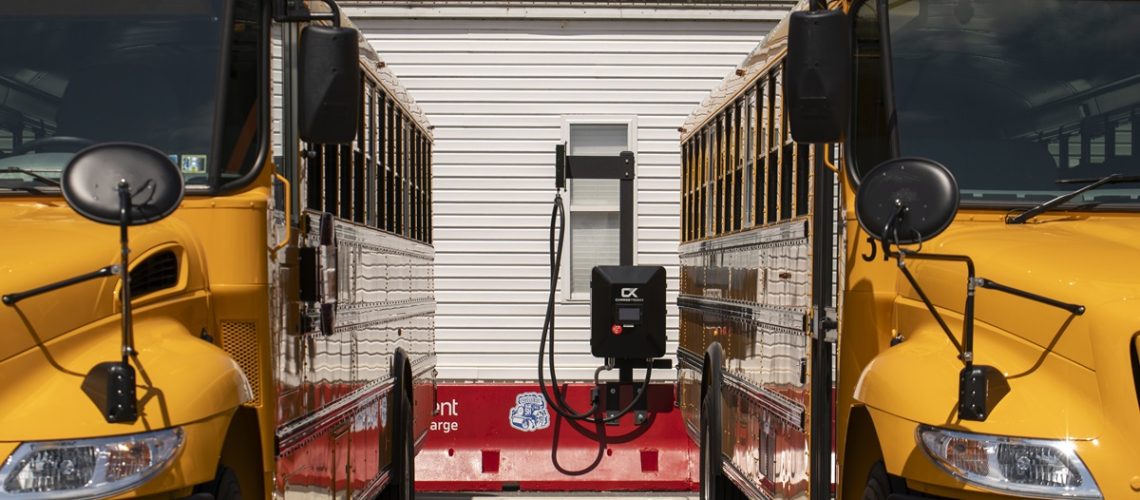Operator First Student committed to deploying 30,000 EV school buses by 2035.
It’s back to school for many of the nation’s students. Big yellow school buses are back on the roads, and an increasing number of them are electric powered.
Cincinnati-based First Student, the largest operator of school bus fleets in the U.S. and Canada, said it plans to deploy 110 new electric school buses in 10 districts this year, bringing its total to 465. The company has received more than $400 million from the Environmental Protection Agency’s Clean School Bus Program and other federal and state programs for its deployments.
Kevin Matthews, head of electrification at First Student, said school bus fleets are excellent candidates for electric vehicles because of their operating patterns and schedules. The average routes are about 80 miles a day – 40 in the morning and 40 in the afternoon – which is well within the range of current technology, he said.
“As we look at the routes we operate today across our 45,000 units, we think we could easily accomplish 75% of these with electric school buses,” Matthews told pv magazine USA.
Last week, the company unveiled six electric school buses for the Steelton-Highspire School District in Pennsylvania that will be charged with a 1.7 MW solar array on the campus that also powers every school building in the district. First Student has a plan in place to deploy 30,000 electric school buses in North America by 2035.
According to Matthews, the overwhelming majority of electric buses his company fields are new builds rather than conversions from diesel-powered vehicles. Three legacy producers of full-size school buses in North America make electric versions: Bluebird; IC Bus, a division of Navistar; and Thomas, a division of Daimler. In addition, new companies dedicated to electric technology are entering the market, notably Quebec-based Lion Electric. Matthews said the Infrastructure Investment and Jobs Act signed into law in 2021 has motivated a lot of this investment in electric technology.
Most school districts contract out their school bus acquisition, maintenance and operations to specialized companies like First Student, which employs nearly 50,000 drivers. Matthews said when his company looks to bring electric vehicles into one of its school district operations, it evaluates 27 factors that bear on the district’s suitability. These factors include length of the routes, the operating temperatures, topography and others that might be considered traditional issues.
“But then we have to get to the cost of electricity and potential issues and logistics related to the installation of charging infrastructure,” he said. “The very first thing we do is contact the local utility. Part of the attractiveness or even the ability to do electric buses is dependent on the cooperation of a utility that has policies to help support that.”
A growing number of states are enacting policies that support the deployment of electric school buses. In New York, for example, Governor Kathy Hochul recently announced that an additional $200 million is being made available to school districts and bus operators for zero-emission school buses through the New York School Bus Incentive Program, which provides support for the purchase of electric buses, charging infrastructure, fleet electrification planning and utility coordination.
In California, school bus service provider Zum announced is deploying 75 electric vehicles to the Oakland Unified School District for the 2024 to 2025 school year, making it the first major district in the U.S. to transition to a 100% electrified student transportation system. Zum said Pacific Gas and Electric cooperated on the charging infrastructure, which involved 74 bi-directional EV chargers. The utility was able to provide 2.7 MW of load to Zum’s Oakland facility, allowing the project to be deployed one year ahead of schedule.
First Student’s Matthews said its electric school buses are proving to be very popular with all concerned, citing lower fuel and maintenance costs when compared to traditional diesel units.
“The drivers like them better,” he said. “The anecdotal evidence is growing that the students are better behaved because the bus is quieter. So, they’re not yelling just to talk. Admittedly, we do not have a peer-reviewed study on this, yet.”
Popular content




